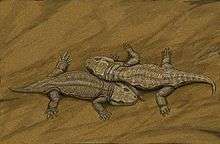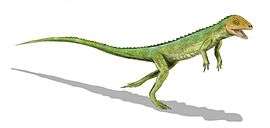Tambach Formation
| Tambach Formation Stratigraphic range: Early Permian, Artinskian | |
|---|---|
| Type | Geological formation |
| Lithology | |
| Primary | Conglomerate, sandstone, mudstone |
| Location | |
| Region | Free State of Thuringia |
| Country |
|
| Type section | |
| Named for | Tambach-Dietharz village |
The Tambach Formation is an Early Permian-age geologic formation in central Germany. It consists of terrestrial lacustrine (lake) and fluvial (river) deposits. Many vertebrate fossils have been found from the formation, including those of early amphibians like Rotaryus and Tambaroter and early reptiles like Eudibamus and Thuringothyris.
Paleobiota
Color key
|
Notes Uncertain or tentative taxa are in small text; |
Amphibians
| Taxon | Member | Material | Notes | Images |
|---|---|---|---|---|
|
Tambach-Sandstein Member |
MNG 11135 (holotype), a small but complete skull. |
|||
|
Tambach-Sandstein Member |
Four individuals are known from the specimens MNG 10181 (holotype), MNG 8760, 8980, 11133, 11134 (paratypes). |
| ||
|
Tambach-Sandstein Member |
MNG 10182 (holotype), articulated partial well-preserved skull and both mandibles and a closely associated partial postcranial skeleton. |
A trematopid dissorophoid temnospondyl. |
||
|
Tambach-Sandstein Member |
MNG 7727, 8759, 10553, 10554 (referred) |
A seymouriid reptiliomorph. |
| |
|
Tambach-Sandstein Member |
Four individuals are known from the specimens MNG 8853 (holotype), MNG 7721, 8747, 8978 (paratypes). |
A diadectid reptiliomorph. |
||
|
Tambach-Sandstein Member |
MNG 7722 (holotype), a crushed skull and much of the postcranial skeleton. |
A trematopid dissorophoid temnospondyl. |
| |
|
Finsterbergen conglomerate Member |
MNG 14708 (holotype), an almost complete skull. |
An ostodolepid microsaur. |
||
Reptiles
| Taxon | Member | Material | Notes | Images |
|---|---|---|---|---|
|
Tambach-Sandstein Member |
MNG 8852 (holotype), an almost complete cranial and postcranial skeleton. |
| ||
|
Tambach-Sandstein Member |
At least eight individuals are known from the specimens MNG 7729 (holotype), MNG 10183, 10647, 10652, 11191 (referred). |
The basalmost known captorhinid eureptile.[11] |
||
Synapsids
| Taxon | Member | Material | Notes | Images |
|---|---|---|---|---|
|
Tambach-Sandstein Member |
MNG 10598 (holotype), partial vertebral column.[12] The referred specimens MNG 10654, 10655, 10693 represent much of the postcranial skeleton. The referred specimen MNG 13433 represents a right maxilla.[13] |
|||
References
- ↑ Jason S. Anderson; Amy C. Henrici; Stuart S. Sumida; Thomas Martens & David S. Berman (2008). "Georgenthalia clavinasica, A New Genus and Species of Dissorophoid Temnospondyl from the Early Permian of Germany, and the Relationships of the Family Amphibamidae". Journal of Vertebrate Paleontology. 28 (1): 61–75. doi:10.1671/0272-4634(2008)28[61:GCANGA]2.0.CO;2.
- ↑ Berman, D. Berman, D. S, Henrici, AC, Kissel, R., Sumida, SS, and Martens, T. S, Henrici, AC, Kissel, R., Sumida, SS, and Martens, T. (2004): A new diadectid (Diadectomorpha), Orobates pabsti, from the Early Permian of Central Germany. Bulletin of the Carnegie Museum of Natural History No 35: pp 1-37. abstract
- ↑ David S. Berman, Amy C. Henrici, Thomas Martens, Stuart S. Sumida and Jason S. Anderson (2011). "Rotaryus gothae, a New Trematopid (Temnospondyli: Dissorophoidea) from the Lower Permian of Central Germany". Annals of Carnegie Museum. 80 (1): 49–65. doi:10.2992/007.080.0106.
- ↑ David S. Berman, Amy C. Henrici, Stuart S. Sumida and Thomas Martens (2000). "Redescription of Seymouria sanjuanensis (Seymouriomorpha) from the Lower Permian of Germany based complete, mature specimens with a discussion of Paleoecology of Bromacker locality assemblage". Journal of Vertebrate Paleontology. 20 (2): 253–268. doi:10.1671/0272-4634(2000)020[0253:rosssf]2.0.co;2.
- ↑ Berman, D.S.; Sumida, S.S.; Martens, T. (1998). "Diadectes (Diadectomorpha: Diadectidae) from the Early Permian of central Germany, with description of a new species". Annals of the Carnegie Museum. 67: 53–93.
- ↑ Kissel, R. (2010). Morphology, Phylogeny, and Evolution of Diadectidae (Cotylosauria: Diadectomorpha). Toronto: University of Toronto Press. p. 185. hdl:1807/24357.
- ↑ Sumida, S.S; Berman, D.S.; Martens, T. (1998). "A new trematopid amphibian from the Lower Permian of central Germany" (PDF). Palaeontology. 41 (4): 605–629.
- ↑ Henrici, A.C.; Martens, T.; Berman, D.S.; Sumida, S.S. (2011). "An ostodolepid 'microsaur' (Lepospondyli) from the Lower Permian Tambach Formation of central Germany". Journal of Vertebrate Paleontology. 31 (5): 997–1004. doi:10.1080/02724634.2011.596601.
- ↑ David S. Berman, Robert R. Reisz, Diane Scott, Amy C. Henrici, Stuart S. Sumida and Thomas Martens (2000). "Early Permian Bipedal Reptile". Science. 290 (5493): 969–972. Bibcode:2000Sci...290..969B. doi:10.1126/science.290.5493.969. PMID 11062126.
- ↑ Johannes Müller, David S. Berman, Amy C. Henrici, Thomas Martens and Stuart S. Sumida (2006). "The basal reptile Thuringothyris mahlendorffae (Amniota: Eureptilia) from the Lower Permian of Germany". Journal of Paleontology. 80 (4): 726–739. doi:10.1666/0022-3360(2006)80[726:TBRTMA]2.0.CO;2.
- ↑ Robert R. Reisz, Jun Liu, Jin-Ling Li and Johannes Müller (2011). "A new captorhinid reptile, Gansurhinus qingtoushanensis, gen. et sp. nov., from the Permian of China". Naturwissenschaften. 98 (5): 435–441. Bibcode:2011NW.....98..435R. doi:10.1007/s00114-011-0793-0. PMID 21484260.
- 1 2 David S. Berman, Robert R. Reisz, Thomas Martens and Amy C. Henrici (2001). "A new species of Dimetrodon (Synapsida: Sphenacodontidae) from the Lower Permian of Germany records first occurrence of genus outside of North America" (PDF). Canadian Journal of Earth Sciences. 38 (5): 803–812. Bibcode:2001CaJES..38..803B. doi:10.1139/cjes-38-5-803.
- ↑ David S. Berman, Amy C. Henrici, Stuart S. Sumida and Thomas Martens (2004). "New materials of Dimetrodon teutonis (Synapsida: Sphenacodontidae) from the Early Permian of central Germany" (PDF). Annals of the Carnegie Museum of Natural History. 73 (2): 48–56.



